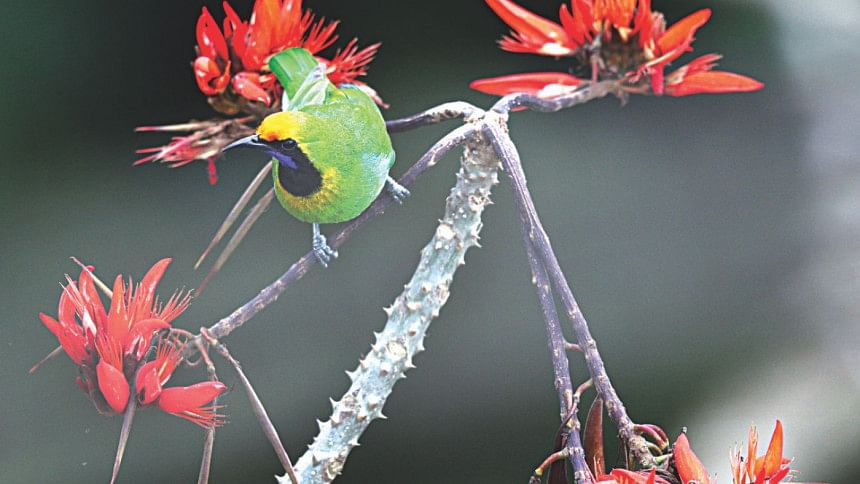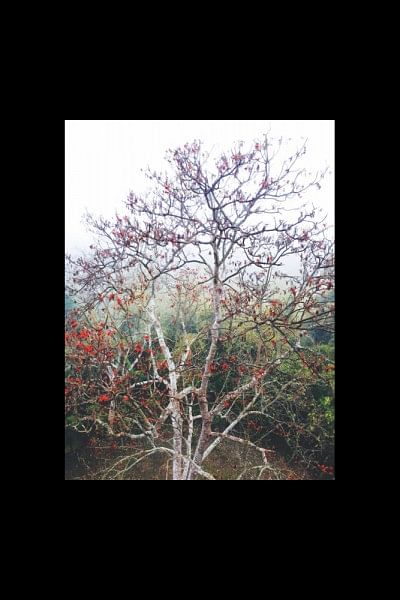Mandar the mother tree

During the first week of this March there was unexpected weather in the country. Forest was no exception. When I tried to hit the famous watch tower in the Satchhari National Park under the Habiganj district my vision was blurred by tiny droplets of the thick mist. I could see a six-storey tall tree that was of the height of the tower. During the spring of 2015 to present time hundreds of Bangladeshi bird photographers swarmed to the top tier of this watch tower just to shoot pictures of birds that get attracted to the flowers crowding at the canopy of the tree. It's Mandar tree, serving as the mother of all trees as maximum number of wildlife visit these flowers, pollinate them and in the process collect nectar and pollen from the large, showy flowers.
Mandar is an indigenous tree with thorny body. Even its leaves are adorned with some spines. In our childhood we used its branches for fencing crop fields to deter cattle, goats and sheep from fields and damaging grains and vegetables. I think people are still continuing the practice as I had seen its practice in the Narikel Jinjira Dwip earlier this year.
There are two species of Mandar in the country. Its common name is Coral Tree, from the coral red flowers that resemble the flowers of Pea or Motorshuti and Palash as these are boat-shaped. Most of these flowers are laden with nectar and are a readymade store of pollens that are relished by insects such as ants, bees, butterflies, some birds and mammals like the bats, squirrels, civets, and small primates.

Naturally, species such as Erythirna ovalifolia or fusca and E variegate or indica are present in our moist deciduous Shal forest and mixed-evergreen or Misrochirosabuj or Chirohorit Bon. These two types of forests used to occur in the central parts of Bangladesh and in northeast to southeast Bangladesh. From time immemorial, people collected seeds of these trees from the forest and planted them in the villages more for their showy vermillion red and large flowers. Later, these trees had gone wild and usually grew on the banks of ponds, dighis and some wetlands. There is virtually no value for their timber either for furniture making or as fuel wood but are of ornamental, aesthetic and crop protection use.
Mandar is a tall, seven to 15 metres, deciduous tree, seasonally the plant becomes completely barren when they all are in flowers. Once the flowers mature and turn to fruits the tree starts getting new shoots that may last almost for nine months or so. The bark is covered with numerous spiky thorns. Its trifoliate, means leaf is divided into three leaflets born on a long petiole. Midribs of leaves often bear soft thorns. The flowers grow in branch or twig tips forming a cluster of several to over a dozen showy crimson, red, orange-red, scarlet or vermillion colours. The tree is usually without any branch in the first few metres of the trunk from the ground level. Then it forms an umbrella-shaped crown of two to three metres in height and more than 10 metres in circumference.
During spring all trees get brilliantly coloured flowers that last for 2 to 3 months. Also, all buds in one tree do not flower at a time. They do so, rather progressively. This is the reason nectivorous birds and other wildlife of a forest or a village could get ready supply of sweet sugary and powdery meals from the bloom of this tree.
In most forests the flowers are in the canopy level of the forest that make them very showy and attractive to the nectar seekers who often fly past the canopies and land there to enjoy a meal.
In the lone tree by the tower in Satchhari, over 50 species of birds, many species of ants, bees, butterflies, monkeys and squirrels have been seen. During my second day of sojourn in the tower I could see almost all species of Mynas or Shaliks, Bulbuls, Moutushis or Sunbirds, Fuljhuri or Flowerpeckers, Orioles, Kokil or Koel and Cuckoos, Parakeets, Lotkon or Hanging Parrots, Drongos, Bashonto Bouri or Barbets, Harichacha or Treepie, Shetakkhi or White-eye, Towfik or Common Iora, Pata Bulbuli or Leafbird or Chloropsis etc. Woodpeckers visited the tree both for nectar and chiselling out insect larvae from the old barks and foliages. And even a Roktochusha or Garden Lizard was found basking in the tree top and later on found it swooping on insects visiting the tree at a height of 10 metres or so! That was very unusual for a garden lizard to be basking in a forest canopy.
So, a lone tree laden with showy flowers could prove to be a mother of all trees as this attracts most nectar, pollen and insect eating birds and other wildlife to such a tree. Such a tree should never be cut from any forest and government property in the country. Also, we should encourage public representatives from village to the town levels to plant not only Mandar but also all indigenous trees and shrubs with showy flowers and soft fleshy fruits. These are bound to entice birds, bats and butterflies, and nocturnal insects and mammals to visit such plants. At the same time these will increase the beauty of the road sides and bridal paths, market places, compounds of educational institutions, premises of offices and play grounds. In addition, these will provide shade to the people, fix nitrogen to the soil and nesting sites for many birds.

 For all latest news, follow The Daily Star's Google News channel.
For all latest news, follow The Daily Star's Google News channel. 



Comments